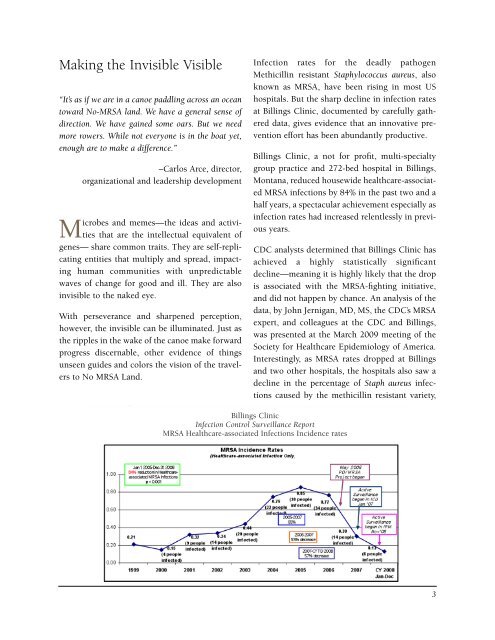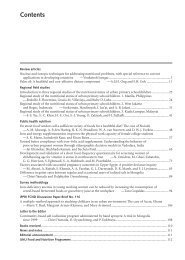From Invisible to Visible - Positive Deviance Initiative
From Invisible to Visible - Positive Deviance Initiative
From Invisible to Visible - Positive Deviance Initiative
You also want an ePaper? Increase the reach of your titles
YUMPU automatically turns print PDFs into web optimized ePapers that Google loves.
Making the <strong>Invisible</strong> <strong>Visible</strong><br />
“It’s as if we are in a canoe paddling across an ocean<br />
<strong>to</strong>ward No-MRSA land. We have a general sense of<br />
direction. We have gained some oars. But we need<br />
more rowers. While not everyone is in the boat yet,<br />
enough are <strong>to</strong> make a difference.”<br />
–Carlos Arce, direc<strong>to</strong>r,<br />
organizational and leadership development<br />
Microbes and memes—the ideas and activities<br />
that are the intellectual equivalent of<br />
genes— share common traits. They are self-replicating<br />
entities that multiply and spread, impacting<br />
human communities with unpredictable<br />
waves of change for good and ill. They are also<br />
invisible <strong>to</strong> the naked eye.<br />
With perseverance and sharpened perception,<br />
however, the invisible can be illuminated. Just as<br />
the ripples in the wake of the canoe make forward<br />
progress discernable, other evidence of things<br />
unseen guides and colors the vision of the travelers<br />
<strong>to</strong> No MRSA Land.<br />
Infection rates for the deadly pathogen<br />
Methicillin resistant Staphylococcus aureus, also<br />
known as MRSA, have been rising in most US<br />
hospitals. But the sharp decline in infection rates<br />
at Billings Clinic, documented by carefully gathered<br />
data, gives evidence that an innovative prevention<br />
effort has been abundantly productive.<br />
Billings Clinic, a not for profit, multi-specialty<br />
group practice and 272-bed hospital in Billings,<br />
Montana, reduced housewide healthcare-associated<br />
MRSA infections by 84% in the past two and a<br />
half years, a spectacular achievement especially as<br />
infection rates had increased relentlessly in previous<br />
years.<br />
CDC analysts determined that Billings Clinic has<br />
achieved a highly statistically significant<br />
decline—meaning it is highly likely that the drop<br />
is associated with the MRSA-fighting initiative,<br />
and did not happen by chance. An analysis of the<br />
data, by John Jernigan, MD, MS, the CDC’s MRSA<br />
expert, and colleagues at the CDC and Billings,<br />
was presented at the March 2009 meeting of the<br />
Society for Healthcare Epidemiology of America.<br />
Interestingly, as MRSA rates dropped at Billings<br />
and two other hospitals, the hospitals also saw a<br />
decline in the percentage of Staph aureus infections<br />
caused by the methicillin resistant variety,<br />
Billings Clinic<br />
Infection Control Surveillance Report<br />
MRSA Healthcare-associated Infections Incidence rates<br />
3

















